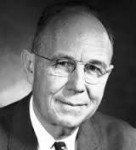
Harold Edgerton
American, 1903-1990
Bullet through Balloons, 1959
gelatin silver print
11 1/2 x 19 in.
SBMA, Gift of the Harold and Esther Edgerton Foundation
1996.18.42

Harold Edgerton - undated photo
"In many ways, unexpected results are what have most inspired my photography." - Harold Edgerton
COMMENTS
Even if you don’t know the name Harold Doc Edgerton you’ve almost certainly seen some of his work. If you’re a photographer than you’ve probably used the equipment he had a hand in developing decades ago. Harold Doc Edgerton is the father of high speed flash photography.
A professor of electrical engineering at M.I.T. , Edgerton changed the way photographers use light to freeze moving subjects and the way the rest of us see the world. He’s best known for changing the stroboscope from a little used piece of laboratory equipment into essential photo gear. Even if that’s all he had ever done, we’d probably still celebrate him because strobes are kind of a big deal in this business, but Edgerton did not stop there. Not content to change the photography world, he kept his eyes peeled for other things he could flash.
Edgerton first got the idea of using the electronic flash of the stroboscope to photograph everyday objects while working on his Sc.D. thesis. He credits the idea to fellow M.I.T. scientist Charles Stark “Doc” Draper. (Apparently there is only one possible nickname for M.I.T. professors.)
While the first thing Edgerton photographed was tap water flowing out of a faucet, he soon moved on to more dramatic subjects like freezing bullets being shot through objects like apples and balloons.
If you look closely at the far right of this picture, you can see the .22 caliber bullet that popped these three balloons. The EG&G Microflash was used to show how the balloon peels away from the inital puncture, until it finally collapses. At the heart of the microflash is a quart or Pyrex tube, around which are wrapped two electrodes coming from from the capacitor. Through the process of conduction, a high voltage spark sent into this tube causes an arc of electricity to jump between the electrodes on the outside, resulting in a bright flash. Unlike most electronic flash lamps, which are filled with xenon, the micro-flash uses plain air. This choice produces a much shorter afterglow from the flash than a xenon lamp. When this flash is triggered, the arc displaces the air around it, much like lightning in a summer storm. And the microflash produces its own thunder, too, like a gun shot. To quiet the noise, a glass tube, sealed with a rubber cork at the open end, encloses the quartz tube. For bullet photography, a reflector is placed around the assembled lamp to concentrate the light in on spot. The exposure is made in total darkness. To trigger the flash at the proper moment, a microphone picks up the sound from the gunshot to fire the micro-flash.
- Harold Doc Edgerton – The Father Of High Speed Flash Photography, Tom Kray, Resource Magazine, August 3, 2014
http://resourcemagonline.com/2014/08/harold-doc-edgerton-the-visionary-engineer/41237/
SBMA CURATORIAL LABELS
Harold ‘Doc’ Edgerton’s specialty was harnessing electricity to freeze time. A pioneer of photographic technology, Edgerton invented the “stroboscope” in 1931, when he synchronized a strobe light to flash at short intervals, allowing viewers to observe moving objects as if they were a series of static images. The ability to photograph rapid motion normally imperceptible to the human eye revolutionized fields as diverse as physics, military surveillance, photojournalism, underwater exploration, and Hollywood filmmaking. Moreover, it reaffirmed the idea that photography was continually capable of transforming our understanding of the physical world.
Edgerton’s interest in the medium started young, when his studio photographer uncle taught him to take, develop, and print pictures. This fascination continued even after he entered the electrical engineering program at the Massachusetts Institute of Technology, first as a Ph.D. student and later as a faculty member. His MIT stroboscopic studies at MIT began in the early 1930s and continued throughout his decades-long tenure there, spreading beyond firmly scientific subjects to include athletes performing complicated physical maneuvers, bullets penetrating a wide range of objects, and droplets of milk splattering into the air.
Although Edgerton was quick to insist his photographs were not intended as art, their aesthetic properties were recognized by others almost immediately. In addition to his work being displayed at London’s Royal Photographic Society in 1933, one photograph was also selected by Beaumont Newhall to appear in the Museum of Modern Art’s first-ever photography exhibition, which opened in 1937. Many have interpreted his images as an expansion of the 19th-century locomotion studies made by figures like Eadweard Muybridge and Étienne-Jules Marey. These mesmerizing photographs, many of which are on view for the first time at the SBMA, reveal the underlying logic and undeniable beauty of the natural world.
- Crosscurrents, 2018
